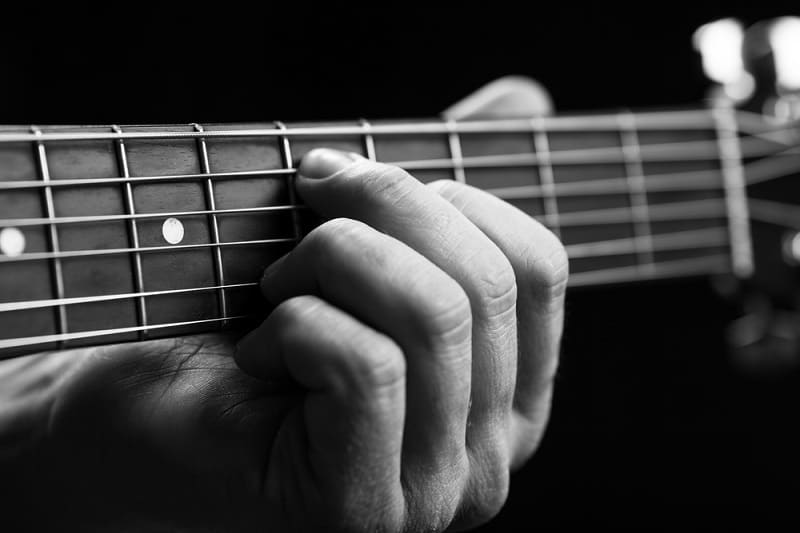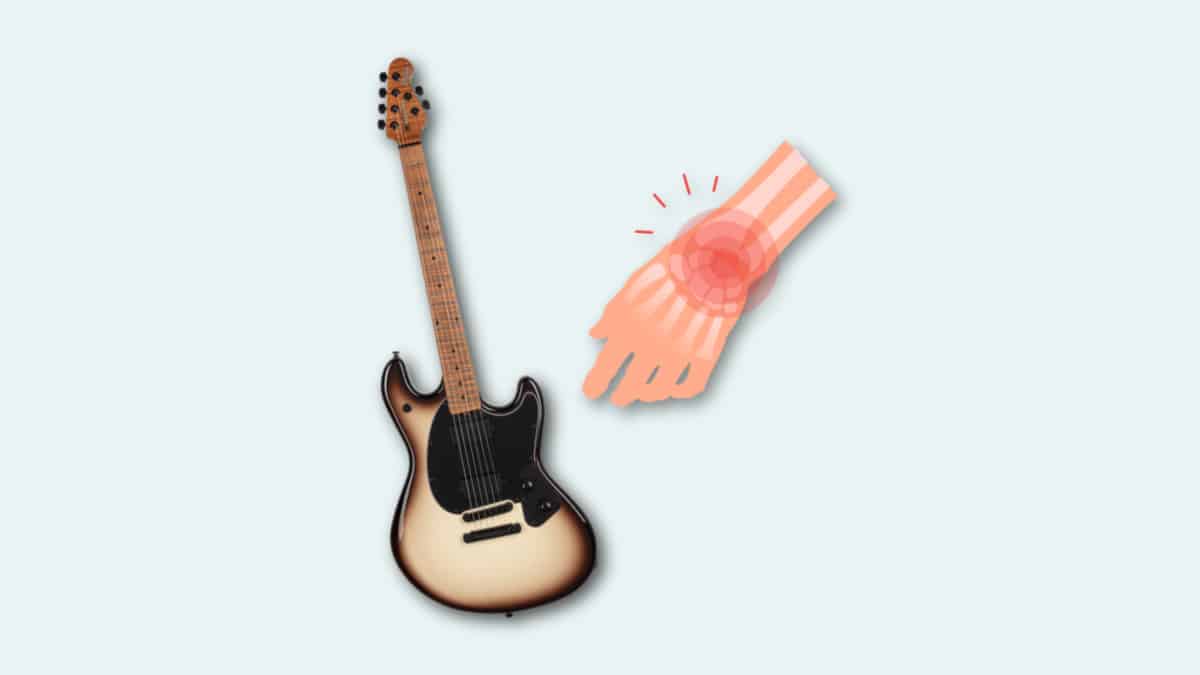(Editor’s Note: Post contributed by David McCombs, an occupational therapist with several years experience in hand therapy.)
As a hand therapist and ergonomic specialist, hand and wrist pain is something I see on a daily basis. Pain can be age-related, occur after an injury or surgery, or it can be related to incorrect posture or positioning.
Everyone experiences pain differently, but pain management for the hand and wrist is the same depending on the type of injury.
Here are a few tips that can help if you’re dealing with guitar wrist pain or hand pain, which can hopefully get you back to playing sooner rather than later.
What Beginners Must Know About Guitar Related Hand and Wrist Pain
The most common guitar related hand and wrist pain comes from incorrect posture or positioning. This is crucial when playing any instrument.
The piano is a perfect example of how much can go wrong by poor positioning. Think about where your legs, arms, wrists, and neck are when you’re sitting at the piano.
Most likely you’re going to be sitting in this position for a while, so it’s important that you have proper body mechanics.
When playing piano, your knees and elbows should be at about 90 degrees of flexion (bending) with your wrists in a neutral/straight position. It’s also important that your neck isn’t flexed forward to read the music.
Guitar is a little different, because of the shape of the instrument, strap preference and standing/sitting position.
However, your body mechanics should follow the same general principles.
Guitar Body Mechanics
- Keep your elbows bent to approximately 90 degrees.
- Keep your wrist in a neutral position.
- If seated, knees should be bent to 90 degrees.
- Maintain good posture.
- Keep your neck in a neutral position.
Proper body mechanics do not come naturally. It takes practice. If you’re used to looking at the fretboard, try to memorize the song by looking away.
If your chair is too tall, find a box or stack printer paper under your feet to keep your knees bent at 90 degrees. (That’s one advantage of being a taller guitar player, you likely won’t need to worry about things like that.)
If you notice your fretting hand is significantly flexed (forward), change the position to neutral or slightly extended (backward).
The general idea with body mechanics is to avoid extreme positions. If you maintain proper body mechanics, you will notice less effort playing the guitar and less strain on your joints.
Guitar Wrist Pain or Hand Pain Related to the Fretting Hand

Starting out, most beginners experience pain and fatigue with their left hand. That’s because the left hand is usually the “fretting” hand. (The opposite would be true if you’re playing guitar left handed.)
Playing the guitar isn’t just about memorization. It’s about strengthening all the muscles from your elbow to your fingers (especially if you use thick guitar strings).
When your fingers don’t have the strength to hold strings against the fretboard, there is a tendency to compensate by using your wrist to help.
As a result, your wrist becomes flexed, and you put strain on the flexor tendons. After time, this may cause cumulative trauma or a repetitive strain injury (RSI) and result in tendonitis or nerve compression (carpal tunnel).
On a related note, one advantage of using a cutaway guitar is that your wrist won’t have to bend as awkwardly.
How to Avoid Wrist Pain With the Fretting Hand
To reduce wrist pain with the fretting hand, it’s important to use proper body mechanics. That means keeping the wrist in a neutral or slightly extended position.
Think about this as a natural position, similar to how you would shake someone’s hand.
Next, the fretting wrist should be anchored to the guitar. In other words, the fingers are doing all the work. (By the way, this may be trickier if you’re playing guitar with long nails.)
Also, look into lowering your guitar action. This means putting the strings closer to the frets so your fingers and wrist have less work to do when holding down a chord.
If you’ve been using improper mechanics for a long time this will be an adjustment. After time, you will notice less wrist strain and stronger fingers.
Top 3 Guitar Related Hand and Wrist Injuries and Treatments
Disclaimer: Before treating any of these injuries, consult your doctor or therapist.
All the injuries mentioned are considered repetitive strain injuries from cumulative stress to the affected joints, tendons, or nerves.
#1 Tendonitis – The Most Common Cause of Guitar Wrist Pain
Do you feel pain and muscle soreness? Tendonitis is all about pain and inflammation. Here’s a more comprehensive guide to treat hand swelling / inflammation.
To treat inflammation remember the acronym RICE:
- Rest
- Ice
- Compression
- Elevation
Rest
Ideally you want to rest the affected upper extremity. If the pain is in the wrist, this may be resolved as you correct the posture.
You may also want to just rest the hand for a few days and do some gentle wrist stretches.
Ice
To decrease pain and inflammation apply ice. Ice is a natural anti-inflammatory and pain reliever.
Start by using an ice pack or make your own in a bag with 50% water and 50% alcohol to store in the freezer.
Place the cold ice pack in a pillowcase and place it on the area that feels painful. Keep the ice pack on for about 20 minutes or until the area feels numb.
Compression and Elevation
Compression and elevation may not be as important for tendonitis unless there is significant swelling, but it wouldn’t hurt to wear a light compression sleeve.
“Tennis Elbow” Can Cause Guitar Wrist Pain in Your Strumming Hand
Tennis elbow, also known as lateral epicondylitis, is a type of tendonitis that occurs after excessive wrist flexion.
While it’s named after tennis, technically it can be caused by various things, including guitar playing.
Usually the pain is felt in the forearm muscles and at the bony prominence near the elbow, but sometimes the pain is felt at the wrist of your strumming hand.
Treatment usually includes rest, ice, massage, and wearing a counterforce brace.
One way to rest your strumming wrist is to try playing fingerstyle guitar.
If you think you have tennis elbow, it wouldn’t be a bad idea to see a hand therapist to instruct you on proper massage techniques and gentle wrist exercises.
A therapist will teach you how to massage the muscle bellies near the elbow to increase blood flow to the tendon and concentric wrist exercises to reduce wrist strain.
A hand therapist can also apply ultrasound that can be beneficial in reducing inflammation.
Plan on purchasing a counterforce brace for the forearm to wear when you start playing the guitar again. A counterforce brace takes off the load from the tendons and can be worn throughout the day to reduce stress at the elbow.
#2 Carpal Tunnel
When you think of carpal tunnel you usually think about someone who types a lot at a desk job. This is usually due to having poor hand and wrist posture for an extended period of time.
But it can also be caused by other repetitive activities, like strumming the guitar.
Carpal tunnel syndrome happens when the median nerve at the wrist becomes compressed. This can cause numbness and tingling in your thumb, index, middle, and half of the ring finger.
If not treated correctly, the hand loses strength, coordination, and the muscle begins to waste away.
Treatment
Carpal tunnel treatment may include:
- Wearing a wrist splint at night
- Wearing a splint to avoid extreme flexion or extension
- Median nerve glides
- Massaging the thenar eminence (the pad of your hand next to your thumb)
In some cases, you may find it easier to use bigger guitar picks, since your wrist may not have to bend as far.
Note: It’s important to know that most people with carpal tunnel syndrome will eventually need surgery.
#3 Arthritis
We all eventually get arthritis with age. Arthritis occurs from joint stiffness and pain. It’s the normal wear and tear of our joints.
Treatment is difficult because movement of the hand and wrist can make arthritic pain more inflamed and painful.
Treatment includes:
- 15 min of heat before playing
- Wear an arthritic glove
- Playing guitar in the early hours of the day
- Low impact exercises (isometric)
- Icing after playing guitar
With Arthritis you want to avoid forceful movements and extreme motion. It’s also good to do isometric exercises that limit finger and wrist range of motion.
Conclusion
Most of the hand injuries discussed here can be avoided by proper body mechanics. If your hand and wrist are in the right position you most likely won’t experience the pain and other problems related to repetitive stress.
I hope these tips were helpful and provided a better idea on how to avoid guitar wrist pain and hand pain.


